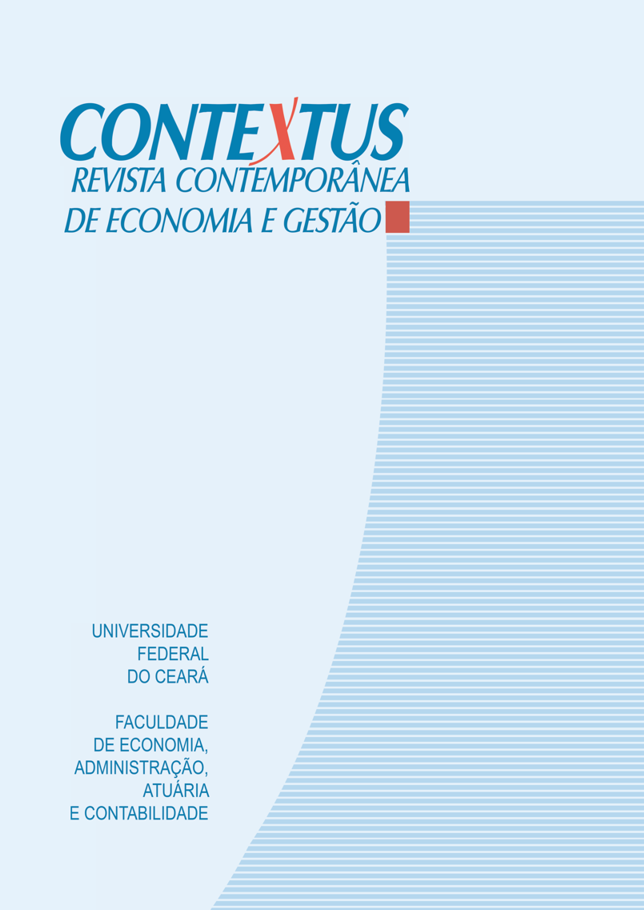Gestión de tono de divulgaciones voluntarias en comunicados de prensa de las sociedades cotizadas en Brasil
DOI:
https://doi.org/10.19094/contextus.2020.43366Palabras clave:
gestión de tonos, gestión de resultados, divulgación voluntaria, análisis textual, notas de prensaResumen
Este artículo tiene como objetivo verificar si las empresas públicas brasileñas manipulan información cualitativa a través de la gestión del tono. Se seleccionaron 43 empresas pertenecientes a Ibovespa da Brasil, Bolsa e Balcão (B3), con datos trimestrales entre 2017 y 2018. Los datos relacionados con el tono positivo fueron formateados por clasificación de palabras por Loughran y McDonald (2011), tomados de los comunicados de prensa publicados voluntariamente por las compañías y analizados por Software Atlas.ti8. El índice retrocedió contra las acumulaciones discrecionales obtenidas en dos modelos de gestión de ganancias. Los resultados apuntan a una relación negativa y significativa entre la gestión contable y el tono positivo de los informes, es decir, las empresas con un tono positivo más alto manejan menos resultados. Estos hallazgos presentan información relevante ya que destaca la calidad de los textos contenidos en los informes de las empresas.
Citas
Beyer, A., Cohen, D. A., Lys, T. Z., & Walther, B. R. (2010). The financial reporting environment: Review of the recent literature. Journal of Accounting and Economics, 50(2-3), 296-343. https://doi.org/10.1016/j.jacceco.2010.10.003
Black, R., & Nakao, S. H. (2017). Heterogeneidade na qualidade do lucro contábil entre diferentes classes de empresas com a adoção de IFRS: evidências do Brasil. Revista Contabilidade & Finanças, 28(73), 113-131. https://doi.org/10.1590/1808-057x201702750
Davis, A. K., Piger, J. M., & Sedor, L. M. (2012). Beyond the numbers: Measuring the information content of earnings press release language. Contemporary Accounting Research, 29(3), 845-868. https://doi.org/10.1111/j.1911-3846.2011.01130.x
Dechow, P. M., & Dichev, I. D. (2002). The quality of accruals and earnings: The role of accrual estimation errors. The Accounting Review, 77(s-1), 35-59. https://doi.org/10.2308/accr.2002.77.s-1.35
Dechow, P. M., Sloan, R. G., & Sweeney, A. P. (1995). Detecting earnings management. The Accounting Review, 70(2), 193-225. https://www.jstor.org/stable/248303
Feldman, R., Govindaraj, S., Livnat, J., & Segal, B. (2010). Management’s tone change, post earnings announcement drift and accruals. Review of Accounting Studies, 15(4), 915-953. https://doi.org/10.1007/s11142-009-9111-x
Giroux, G. (2004). Detecting earnings management. New Jersey: John Wiley & Sons Incorporated.
Gray, S. J., Meek, G. K., & Roberts, C. B. (1995). International capital market pressures and voluntary annual report disclosures by US and UK multinationals. Journal of International Financial Management & Accounting, 6(1), 43-68. https://doi.org/10.1111/j.1467-646X.1995.tb00049.x
Hales, J., Kuang, X. I., & Venkataraman, S. (2011). Who believes the hype? An experimental examination of how language affects investor judgments. Journal of Accounting Research, 49(1), 223-255. https://doi.org/10.1111/j.1475-679X.2010.00394.x
Healy, P. M., & Wahlen, J. M. (1999). A review of the earnings management literature and its implications for standard setting. Accounting Horizons, 13(4), 365-383. https://doi.org/10.2308/acch.1999.13.4.365
Huang, X., Teoh, S. H., & Zhang, Y. (2013). Tone management. The Accounting Review, 89(3), 1083-1113. https://doi.org/10.2308/accr-50684
Kang, S. H., & Sivaramakrishnan, K. (1995). Issues in testing earnings management and an instrumental variable approach. Journal of Accounting Research, 353-367. https://doi.org/10.2307/2491492
Kothari, S. P., Leone, A. J., & Wasley, C. E. (2005). Performance matched discretionary accrual measures. Journal of Accounting and Economics, 39(1), 163-197. https://doi.org/10.1016/j.jacceco.2004.11.002
Kruglanski, A. W., & Thompson, E. P. (1999). Persuasion by a single route: A view from the unimodel. Psychological Inquiry, 10(2), 83-109. https://doi.org/10.1207/S15327965PL100201
Loughran, T., & McDonald, B. (2011). When is a liability not a liability? Textual analysis, dictionaries, and 10‐Ks. The Journal of Finance, 66(1), 35-65. https://doi.org/10.1111/j.1540-6261.2010.01625.x
Oliveira, H. M. S., Lopes, C. M. F. P., & Cunha, C. A. S. (2008). A transparência da informação por parte dos emitentes. Revista Universo Contábil, 4(2), 93-104. https://doi.org/10.4270/ruc.20084
Paulo, E. (2007). Manipulação das Informações Contábeis: Uma Análise Teórica e Empírica Sobre os Modelos Operacionais de Detecção de Gerenciamento de Resultados. (Tese de Doutorado em Ciências Contábeis). Universidade de São Paulo, São Paulo, SP, Brasil. https://www.teses.usp.br/teses/disponiveis/12/12136/tde-28012008-113439/pt-br.php
Petty, R. E., & Cacioppo, J. T. (1986). The elaboration likelihood model of persuasion. In Communication and Persuasion (pp. 1-24). Springer, New York, NY. https://link.springer.com/chapter/10.1007/978-1-4612-4964-1_1
Popova, T., Georgakopoulos, G., Sotiropoulos, I., & Vasileiou, K. Z. (2013). Mandatory disclosure and its impact on the company value. International Business Research, 6(5), 1-16. https://doi.org/10.5539/ibr.v6n5p1
Sloan, R. G. (1996). Do stock prices fully reflect information in accruals and cash flows about future earnings? The Accounting Review, 71(3), 289-315. https://www.jstor.org/stable/248290
Subramanyam, K. R. (1996). The pricing of discretionary accruals. Journal of accounting and economics, 22(1-3), 249-281. https://doi.org/10.1016/S0165-4101(96)00434-X
Tetlock, P. C., Saar‐Tsechansky, M., & Macskassy, S. (2008). More than words: Quantifying language to measure firms' fundamentals. The Journal of Finance, 63(3), 1437-1467. https://doi.org/10.1111/j.1540-6261.2008.01362.x
Watts, R. L. & Zimmerman, J. L. (1986). Positive Accounting Theory. New Jersey: Prentice Hall.
Watts, R. L., & Zimmerman, J. L. (1990). Positive accounting theory: a ten year perspective. Accounting Review, 65(1), 131-156. https://www.jstor.org/stable/247880
Descargas
Publicado
Cómo citar
Número
Sección
Licencia
The authors, while doing the submission, accept the notice below:
We authors hold the copyright related to our paper and transfer Contextus journal the right for the first publication with a Creative Commons’ international license of the modality Attribution – Non-commercial 4.0, which in turn allows the paper to be shared providing that both the authorship and the journal’s right for initial release are acknowledged.
Furthermore, we are aware of our permission to take part in additional contracts independently for non-exclusive distribution of the version of our work published in this journal (e.g. publishing it in an institutional repository or as a book chapter), while acknowledging both the authorship and the journal’s initial publication.
We also certify that the paper is original and up to this date has not been released in any other journal, Brazilian or of another nationality, either in Portuguese or another language, as well as it has not been sent for simultaneous publication in other journals.
Last, we not only know that plagiarism is not tolerated by Contextus but also certify the paper presents the sources of passages from cited works, including those authored by ourselves.


